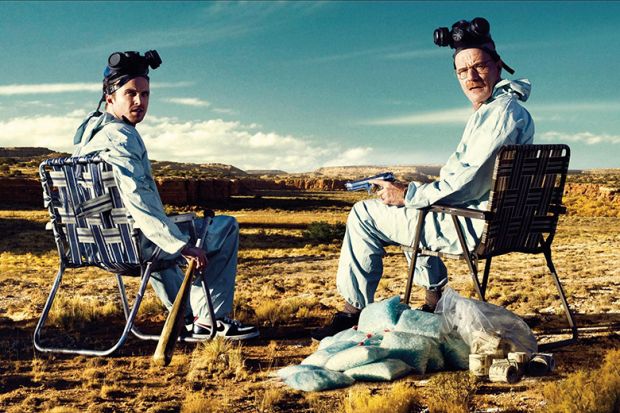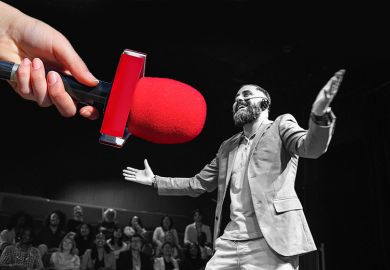Nearly six years on from the dramatic climax of Breaking Bad, the travails of Walter White and Jesse Pinkman remain etched in the memories of millions of television viewers.
But for Donna Nelson, it’s the science of the hit crime drama that still resonates. The professor of chemistry at the University of Oklahoma said that the science of the five-season epic – which followed teacher Walt (Bryan Cranston) and his turn to a life of crime producing and selling crystal methamphetamine with former student Jesse (Aaron Paul) – was at times “so spectacular it seems to be a separate character”.
At certain points, “you are focused so much on the science that the characters just seem to fade into the background”, she said.
“There is one scene where they are trying to break into the chemical storage unit,” she recalled. “They use thermite to break the lock of the door, and when they ignite the thermite the sparks just shine across the screen.
“It’s night-time and Walt and Jesse are both dressed in black, and the only thing that you can see is the chemical reaction taking place – everything else fades away into the darkness.”
That Professor Nelson has a particular passion for the chemistry of Breaking Bad is not altogether surprising: she volunteered to serve as the show’s scientific adviser for much of its run after reading an article in which its creator, Vince Gilligan, lamented that the lack of money to pay a consultant forced his writers to rely on the internet for scientific know-how.
It was a wonderful opportunity to promote science, she said, “because television reaches the public, and our regular science journals and scientific meetings do not”.
But Professor Nelson – at that stage already a leading scholar in her field – recalled feeling that she could “not even have the appearance of being involved” in a show about crystal meth.
However, she watched every episode that had been made up to that point and “realised the way it was set up was that every time Walt or Jesse did anything wrong, they got punished, so the show was just filled with morals. I thought I could be affiliated with this since it’s not glorifying illegal drugs or the illegal drug community.”
Professor Nelson has now written, with Dave Trumbore, a book called The Science of Breaking Bad, which explains everything from Walt’s DIY battery-making to the feasibility of using hydrofluoric acid to dissolve bodies and the chemistry of methamphetamine itself.
She told Times Higher Education that once you accepted that the show was not a science documentary, its portrayal of chemistry was “really pretty accurate”.
However, there was one crucial point on which Mr Gilligan refused to take her advice – the colouring of the supposedly super-pure blue meth produced by Walt and Jesse.
“I said it wouldn’t [actually go blue], and he said why not? And I said because meth is white, and he said but what if it’s pure? And I said then it will still be white.
“And he said what if it’s really, really, really pure? And I said then it will be really, really, really white.
“So I got my point across, but he went ahead and made the meth blue because it was a plot device – they needed a trademark for Walt. And again, the show is fiction: they have no responsibility to get the science correct, although they did in most cases.”
Six years on, Professor Nelson said that she believed that the show had had a significant legacy, in particular getting more young people interested in science. Several high school students had contacted her to say that they had been inspired to start science blogs because they had enjoyed the TV series so much, she said.
“That really made me think that the show did inspire kids, and then of course a lot of students told me that it did,” Professor Nelson said.
And for Professor Nelson herself, who served as president of the American Chemical Society in 2016, being part of the Breaking Bad story was a transformative experience.
She even got the opportunity to film a cameo appearance as a nursing home attendant, although it did not make the final cut.
“It was fun. I learned about working in a different culture. I received many invitations to speak about my experiences. Many people wanted to interview me,” Professor Nelson said.
“I received publicity of a kind that I never would have had without this experience.”
Professor Nelson recalled going on a whistle-stop tour of six cities in Germany, and at every one students packed into lecture theatres and overflow rooms.
“I have never seen anything like that at a scientific lecture before,” she said. “The students would come to my seminar dressed in hazmat suits.”
nick.mayo@timeshighereducation.com
The Science of Breaking Bad by Dave Trumbore and Donna Nelson is set to be published in June.
POSTSCRIPT:
Print headline: Let’s cook: how Breaking Bad stirred up a taste for science
Register to continue
Why register?
- Registration is free and only takes a moment
- Once registered, you can read 3 articles a month
- Sign up for our newsletter
Subscribe
Or subscribe for unlimited access to:
- Unlimited access to news, views, insights & reviews
- Digital editions
- Digital access to THE’s university and college rankings analysis
Already registered or a current subscriber?







